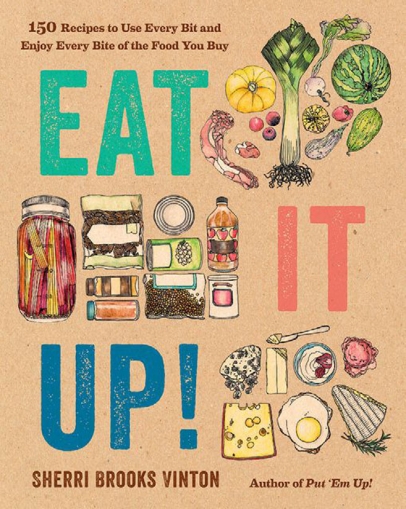Reasons To Eat It Up!
SAVES MONEY
Food costs. Throw out your food and you’re throwing out your money. It’s hard to imagine buying new clothes then coming home and throwing half of them away, yet that’s what many of us do with our food. Maybe not all at once, but a little bit at a time. And it adds up. I sometimes catch myself as I’m about to toss out some- thing that represents a relatively small percentage of my total grocery bill, such as leftover rice. It’s easy to just pitch it, but by doing so I’m getting less for the money.
Half of last night’s rice, a few bites of chicken, a handful of broccoli florets. That amount of food is often discarded without a second thought. But when you stop to look at it, you haven’t just thrown out a bite of this and that. Sauté it up with an onion and maybe some sesame oil and you’ve got dinner. Save those bits and bobs and you haven’t just saved the cost of the leftovers, but the cost of the new meal you didn’t have to make. Eating it up, saves it up. After all, no one ever got rich by wasting money—or food.
SAVES TIME
We’re busy people with busy lives. Who wouldn’t want an extra slice of time in their week? Using up what you have on hand can mean more efficient trips to the market. Utilizing leftovers from last night’s dinner gives you a running start on tonight’s meal prep. Eat it up and you’ll spend less time buying and cooking it up.
TASTES GREAT
There’s no sustainable kitchen practice that’s worth a fig if it doesn’t lead to a tasty meal. Food is about pleasure, first and foremost. Although there are a lot of reasons to support local agriculture—from environmental to social to economic—I was lured into the Real Food movement by my taste buds. Locally raised, in-season, fresh-from-the-field grub is the tastiest you will find. When I’m eating up every last bite of the food I have in my kitchen, I’m not thinking, ‘Oh, clever frugal me’; I’m thinking, ‘Dang, that looks tasty.’
I can remember my Granny Toni giving the emptied jar of her home-canned tomatoes a swish with a little water and pouring it into whatever sauce she was making. I made some wisecrack about her being such a penny-pincher and she said to me, “It’s not just the money, it’s the flavor. You’ve got to get all the flavor into the pot.” I think of that every time I take the extra effort to get to the dregs of the jam jar, the last bit of pickle juice in the crock. Don’t waste it, taste it!
PRESERVES NATURAL RESOURCES
It takes a lot to grow food. A lot of water, a lot of energy, a lot of fresh air and sun- shine. Every step in the process—from planting the seeds to weeding to harvesting and shipping—is quite resource intensive. Machinery needs to be powered. Fields are irrigated. Crops are transported. Even the most sustainably run farm uses natural resources to produce the good food that fills our plates. By enjoying every last bite of the food that comes out of this process, we lower the resource-to-calorie quotient. Eat it up and you’ll be doing your part to use but not waste the air, water, soil and energy it takes to grow our crops.
HONORS THE FARMERS’ HARD WORK
Accountant, marketer, customer service representative, advertising exec, machinist, weather forecaster, ecologist, community organizer—these are just some of the jobs that a modern farmer needs to be expert at these days.
Oh, and having the ability to actually grow food. And not just make it come out of the ground but do it well. That means properly prepping the soil so the carrots grow straight, knowing the exact moment to harvest broccoli before it bolts, curing the sweet potatoes so they don’t rot, under- standing the positive effects of frost on parsnips, puzzling out your fields with underplantings and crop rotations that not only maximize the space, but encourage fertility and more. And doing all those things before many of us have even had our first cup of coffee. It’s not just hard work, it’s incredible shape-shifting, mystical, miracle- making stuff. The best way to honor the blood, sweat and tears it takes to fill your market basket? Eat it. Every bite of it.
MAXIMIZES FARMLAND PRODUCTIVITY
More people means we need to grow more food, right? Well, how about instead of growing more, we just eat what’s already there. Americans only consume about half of the food that comes off our fields. Simple math, we can have about twice as much food without planting a single acre more, if we just eat what we grow.
Excerpted from Eat It Up!: 150 Recipes to Use Every Bit and Enjoy Every Bite of the Food You Buy by Sherri Brooks Vinton. Copyright © 2016. Available from Da Capo Lifelong Books, an imprint of Perseus Books, LLC, a subsidiary of Hachette Book Group, Inc.




